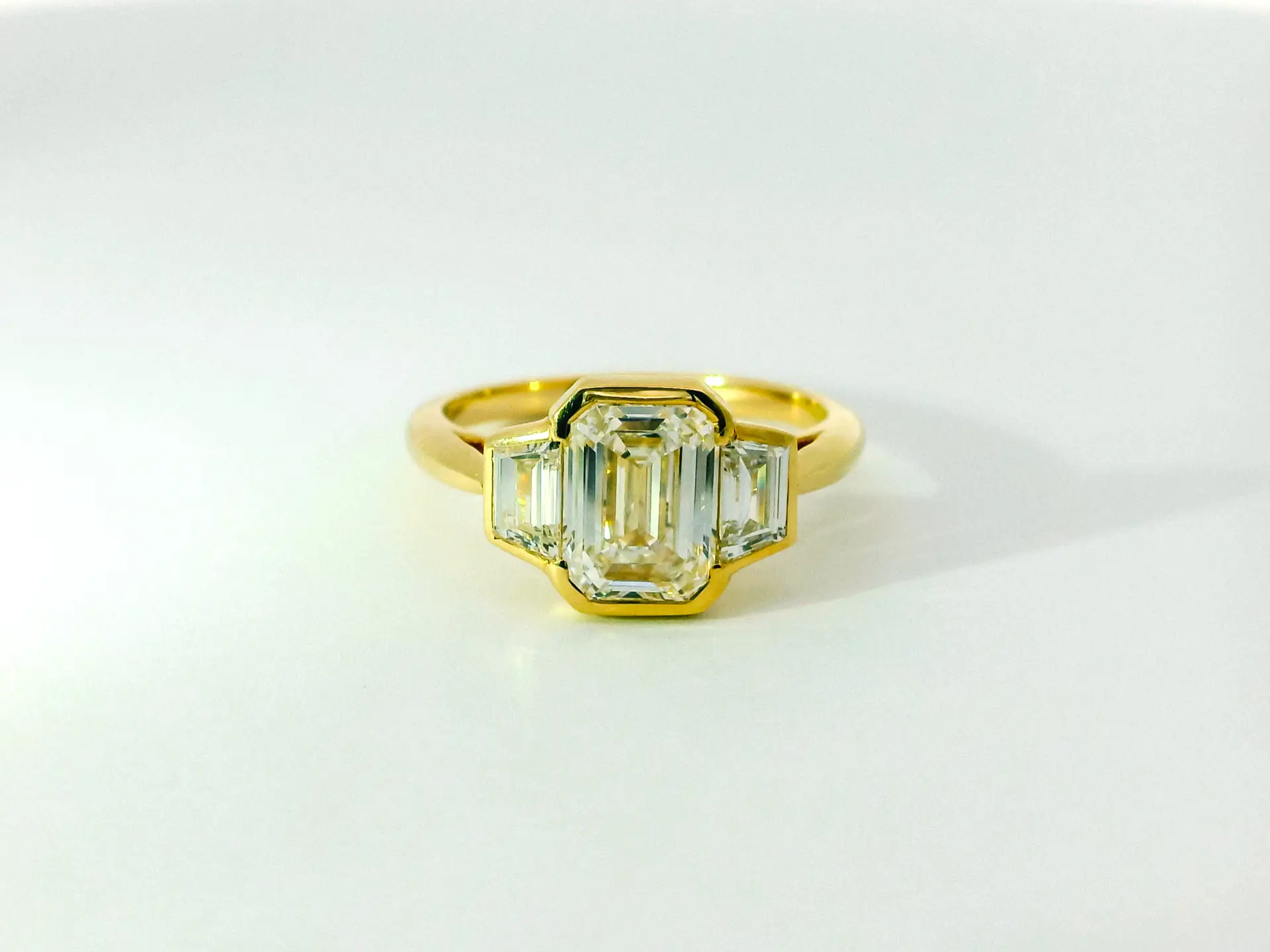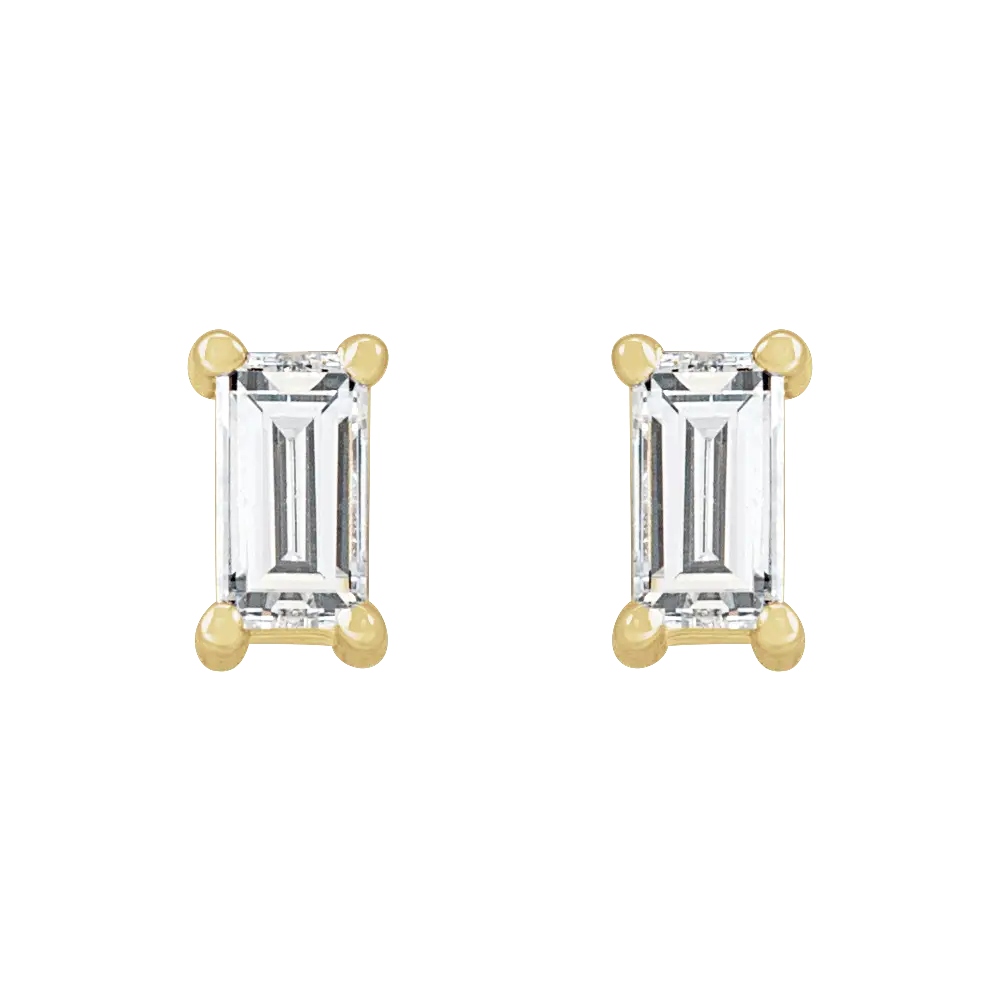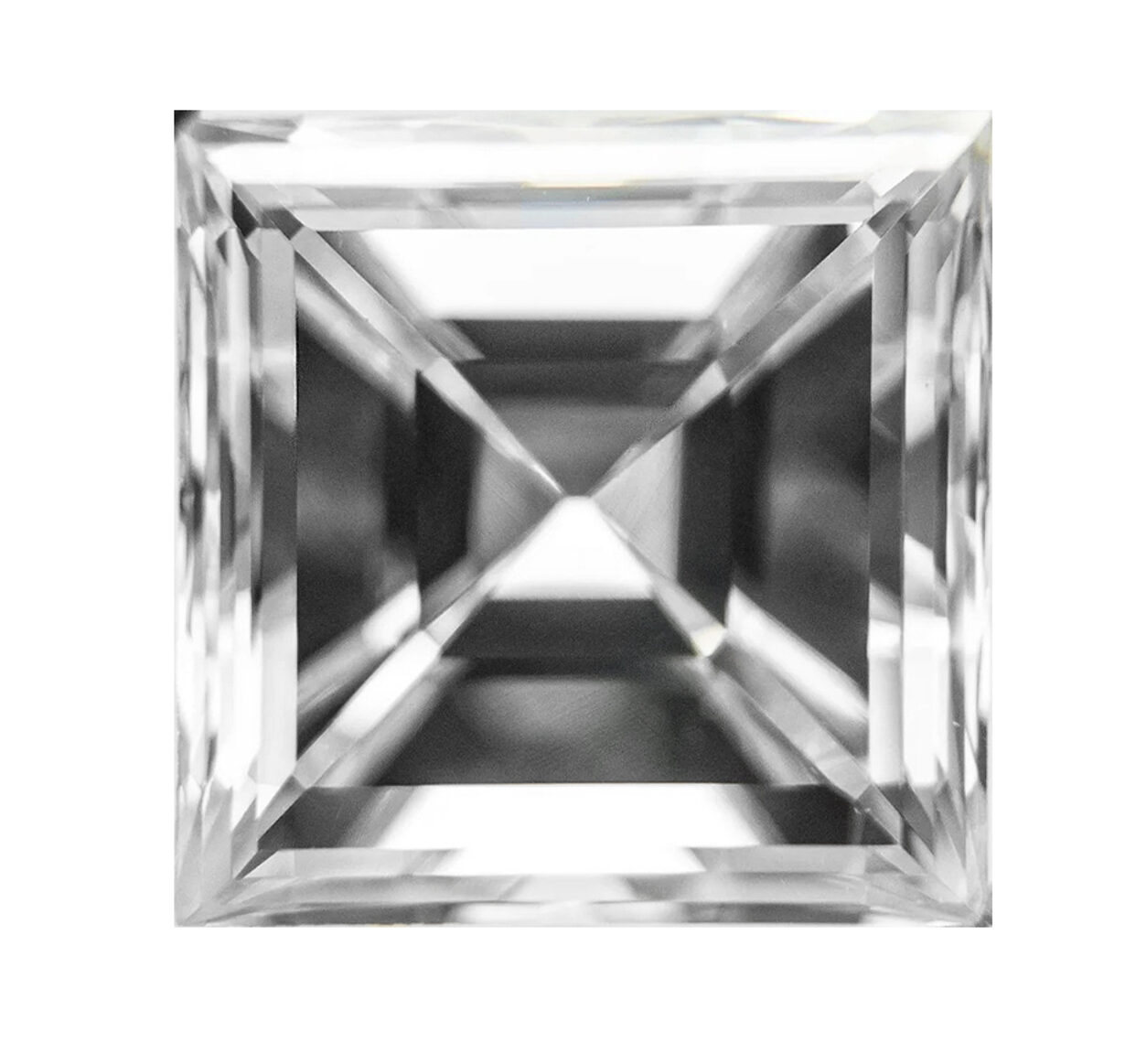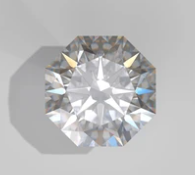
Step-cut diamonds are known for their elegant, sophisticated appearance, focusing on clarity and a unique play of light rather than intense sparkle. Unlike brilliant cuts, which use triangular and kite-shaped facets to maximize brilliance, step cuts feature long, parallel, and rectangular facets that create a mesmerizing “hall of mirrors” effect.
If brilliant-cut diamonds are like fireworks—full of sparkle and movement—step cuts are like a mirror-lined ballroom: refined, symmetrical, and dramatic.
1. What is a Step Cut? #
A step cut is a diamond cut that uses rectangular or trapezoidal facets arranged in parallel rows. These facets resemble steps on a staircase, hence the name.
Key Features of Step Cuts
-
Long, parallel facets create broad flashes of light rather than scintillation.
-
Open table (large, flat top facet) enhances transparency.
-
Fewer facets (compared to brilliant cuts), leading to a more structured look.
-
Emphasizes clarity – inclusions are more visible, so a higher clarity grade is preferred.
-
Subtle elegance – Instead of sparkle, it offers a deep, sophisticated glow.
💡 Analogy: If a brilliant cut is like crushed ice reflecting light in all directions, a step cut is like a perfectly still lake, reflecting light in broad flashes.
2. Types of Step Cut Diamonds #
There are several types of step cuts, each with its own distinct personality.

A. Emerald Cut
🔹 Most popular step cut
🔹 Shape: Rectangular with cut corners
🔹 Facets: Typically 57-58
🔹 Best for: Those who love elegance and understated beauty
The emerald cut is the most famous and widely recognized step cut. It features three rows of step-cut facets on the crown (top) and three on the pavilion (bottom). The corners are slightly cropped, making it more durable.
💡 Effect: The elongated shape makes fingers look longer, and its large table offers a clear view into the stone.

B. Asscher Cut
🔹 Square version of the emerald cut
🔹 Shape: Square with cut corners (octagonal outline)
🔹 Facets: Typically 57-58
🔹 Best for: Vintage lovers and Art Deco fans
The Asscher cut, first developed in 1902 by the Asscher family, became popular in the Art Deco era. It has the same step-cut structure as an emerald cut but with a deeper pavilion and a higher crown, giving it more brilliance than other step cuts.
💡 Effect: The “hall of mirrors” effect is more pronounced due to its deeper facets and higher crown.

C. Baguette Cut
🔹 Often used as side stones
🔹 Shape: Narrow, rectangular, and elongated
🔹 Facets: Typically 14
🔹 Best for: Accent stones in engagement rings or jewelry settings
The baguette cut has fewer facets than the emerald or Asscher cuts, meaning it relies even more on clarity. These diamonds are often used as side stones in rings or as accents in jewelry.
💡 Effect: Because it has fewer facets, it offers a sleek, clean look but lacks the deep light reflection of other step cuts.

D. Carre Cut
🔹 Similar to Asscher but with sharp corners
🔹 Shape: Square, without cropped corners
🔹 Facets: Typically 24-32
🔹 Best for: Those who want a more structured and defined step cut
The Carre cut is less common than the Asscher cut and features sharp, uncut corners, making it look more like a perfect square. It has strong flashes of light, but since it lacks cropped corners, it can be more fragile.
💡 Effect: Creates strong light reflections but lacks the brilliance of Asscher or emerald cuts.

E. Octagon Cut
🔹 Extended version of the Asscher cut
🔹 Shape: Octagonal (eight-sided)
🔹 Facets: Typically 53-58
🔹 Best for: Those who love geometric precision
The Octagon cut is a rare step cut that takes the Asscher’s design and makes it even more geometric. It provides a bold and structured look.
💡 Effect: Creates a striking, symmetrical shape with a deep hall-of-mirrors effect.
3. The Science of Step Cuts: Light Performance #
Unlike brilliant cuts, which reflect light in multiple directions for a fiery sparkle, step cuts are designed for broad, bold reflections.
How Light Behaves in a Step Cut
-
Light enters the diamond through the table.
-
It reflects in long, parallel flashes instead of the chaotic dispersion seen in brilliant cuts.
-
Fewer light leaks than in poorly cut brilliant diamonds, but less “fire” (rainbow dispersion).
-
Creates a deep, mirror-like effect instead of a glittering sparkle.
💡 Analogy: Think of a hallway with large mirrors on both sides. Instead of a scattered light show, you see deep, structured reflections.
4. Choosing a Step Cut Diamond: The 4Cs #
Because step cuts lack the brilliance of round brilliants, they rely more on clarity and cut quality to maintain their elegance.
A. Cut
-
Proportions matter! A well-cut step diamond ensures proper depth and balance.
-
Too shallow = Less reflection and a dull look.
-
Too deep = Light leaks through the bottom, making it darker.
B. Clarity
-
Step cuts reveal inclusions more than brilliant cuts.
-
Opt for VS1 or better to ensure a clean appearance.
-
Asscher and emerald cuts require higher clarity grades since inclusions are more visible through the large table.
C. Color
-
Since step cuts don’t reflect as much light, they show more color.
-
Choose H color or higher for a near-colorless appearance.
D. Carat
-
Step cuts appear larger than brilliant cuts of the same carat weight due to their broader surface area.
-
1.5-carat step cut may look as big as a 2-carat round diamond!
💡 Pro Tip: Step cuts highlight clarity and elegance over brilliance, so prioritize high-quality stones over sheer size.
#
5. Pros and Cons of Step Cut Diamonds #
Pros:
✅ Elegant and timeless – Perfect for a refined, classic look.
✅ Unique light performance – Bold flashes of light instead of glittering sparkle.
✅ Larger face-up appearance – Looks bigger than round brilliants of the same carat.
✅ Great for vintage and Art Deco styles – Popular in historical jewelry designs.
Cons:
❌ Shows inclusions more easily – Requires higher clarity grades.
❌ Less sparkle than brilliant cuts – Lacks the fiery brilliance some people prefer.
❌ More fragile corners (except for Asscher and emerald cuts) – Can chip if not well protected.
#
6. Who Should Choose a Step Cut Diamond? #
Step cuts are ideal for those who prefer sophistication over sparkle. They suit:
💍 Lovers of vintage elegance – Step cuts are famous in Art Deco and antique jewelry.
💍 People who value clarity over brilliance – Since these diamonds don’t sparkle as much, a clean stone is crucial.
💍 Minimalists and those who love geometric shapes – The precise, linear faceting appeals to modern tastes.
Final Thoughts #
Step cuts offer timeless beauty, elegance, and a sophisticated light performance that sets them apart from brilliant cuts. If you’re drawn to the clean, structured look of step cuts, choosing a high-clarity, well-cut diamond will ensure its beauty shines through.


